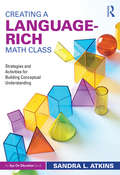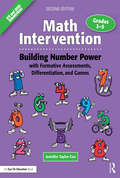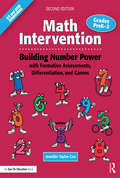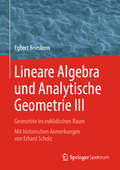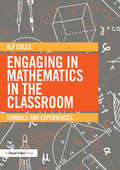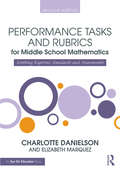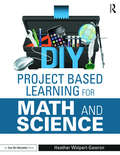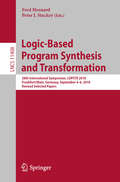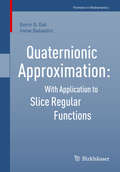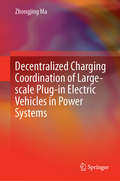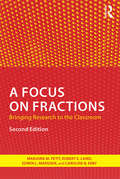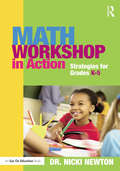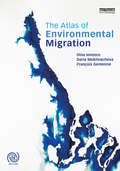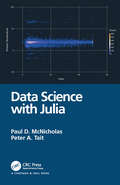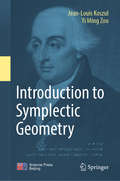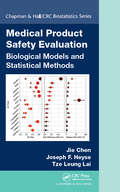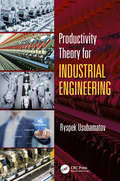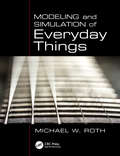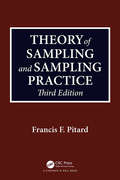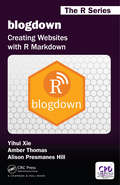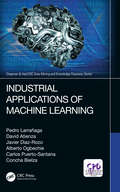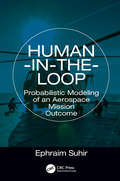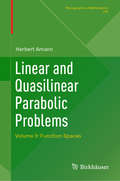- Table View
- List View
Creating a Language-Rich Math Class: Strategies and Activities for Building Conceptual Understanding
by Sandra L. AtkinsWhat meanings do your students have for key mathematics concepts? What meanings do you wish them to have? Creating a Language-Rich Math Class offers practical approaches for developing conceptual understandings by connecting concrete, pictorial, verbal, and symbolic representations. The focus is on making mathematics memorable instead of on memorizing. You’ll learn strategies for introducing students to math language that gives meaning to the terms and symbols they use everyday; for building flexibility and precision in students’ use of math language; and for structuring activities to make them more language-rich. Book Features: Detailed directions for sample games and activities for immediate classroom use; Investigations to Try and Questions for Reflection to assist in implementing these ideas into your practice; Graphic organizer for helping students first understand, solve, and defend their solutions to word problems; Blackline masters of game cards and puzzles (also available at http://www.routledge.com/books/details/9781138916296/)
Creating a Language-Rich Math Class: Strategies and Activities for Building Conceptual Understanding
by Sandra L. AtkinsWhat meanings do your students have for key mathematics concepts? What meanings do you wish them to have? Creating a Language-Rich Math Class offers practical approaches for developing conceptual understandings by connecting concrete, pictorial, verbal, and symbolic representations. The focus is on making mathematics memorable instead of on memorizing. You’ll learn strategies for introducing students to math language that gives meaning to the terms and symbols they use everyday; for building flexibility and precision in students’ use of math language; and for structuring activities to make them more language-rich. Book Features: Detailed directions for sample games and activities for immediate classroom use; Investigations to Try and Questions for Reflection to assist in implementing these ideas into your practice; Graphic organizer for helping students first understand, solve, and defend their solutions to word problems; Blackline masters of game cards and puzzles (also available at http://www.routledge.com/books/details/9781138916296/)
Math Intervention 3-5: Building Number Power with Formative Assessments, Differentiation, and Games, Grades 3-5
by Jennifer Taylor-CoxHelp all of your students reach success in math! This essential book, from bestselling author and consultant Jennifer Taylor-Cox, is filled with suggestions that teachers and RTI/MTSS specialists can use to target instruction for struggling students in grades 3-5. You’ll learn how to diagnose academic weaknesses, differentiate instruction, use formative assessments, offer corrective feedback, and motivate students with games and activities. The book’s practical features include… Directions for incorporating formative assessments; Explanations of successful strategies for intervention; Important math terms to use with students; Games for active learning with printable boards; Cognitive demand questions ranging from easy to complex; and Rigorous problems to help you gather pre and post data. In this enhanced second edition, you’ll find correlations to the Common Core throughout, as well as a variety of brand new, rigorous problems designed to mirror those on CCSS assessments. Bonus! The book is accompanied by free eResources on our website, www.routledge.com/9781138915695. These eResources include an Answer Key with Scoring Guide and a handy Progress Monitoring Tool that you can use to track each student’s growth, record notes, and share data with parents, administrators, and other educators. The eResources also contain printable versions of the games in the book so that you can easily download and print them for classroom use.
Math Intervention P-2: Building Number Power with Formative Assessments, Differentiation, and Games, Grades PreK–2
by Jennifer Taylor-CoxHelp all of your students reach success in math! This essential book, from bestselling author and consultant Jennifer Taylor-Cox, is filled with suggestions that teachers and RTI/MTSS specialists can use to target instruction for struggling students in PreK-2. You’ll find out how to diagnose academic weaknesses, differentiate instruction, use formative assessments, offer corrective feedback, and motivate students with games and activities. The book’s practical features include… Directions for incorporating formative assessments; Explanations of successful strategies for intervention; Important math terms to use with students; Games for active learning with printable boards; Cognitive demand questions ranging from easy to complex; and Rigorous problems to help you gather pre and post data. In this enhanced second edition, you’ll find correlations to the Common Core throughout, as well as a variety of brand new, rigorous problems designed to mirror those on CCSS assessments such as the PARCC and SBAC. Bonus! The book is accompanied by free eResources on our website, www.routledge.com/9781138915626. These eResources include an Answer Key with Scoring Guide and a handy Progress Monitoring Tool that you can use to track each student’s growth, record notes, and share data with parents, administrators, and other educators. The eResources also contain printable versions of the games in the book so that you can easily download and print them for classroom use.
Lineare Algebra und Analytische Geometrie III: Geometrie im euklidischen Raum. Mit historischen Anmerkungen von Erhard Scholz
by Egbert BrieskornDieser Band ist der dritte Teil des Lehrbuches von Egbert Brieskorn zur Linearen Algebra und analytischen Geometrie und legt den Schwerpunkt auf die Geometrie im euklidischen Raum. Er beginnt mit einem sorgfältigen Studium der Isometriegruppen euklidischer affiner Räume und ihrer Ähnlichkeitsabbildungen, führt über die Länge rektifizierbarer Kurven den Winkelbegriff der euklidischen Geometrie ein und entwickelt die Grundkonzepte der ebenen und sphärischen Trigonometrie. Daran schließt der Autor eine sorgfältige Diskussion der Isometriegruppen und der konformen Abbildungen der Sphären an und streicht die resultierende Sonderstellung der Sphären unter den kompakten Riemannschen Mannigfaltigkeiten heraus. Anschließend an eine Bemerkung Hermann Weyls über die tief liegende Rolle des Spins für die euklidische Geometrie macht der Autor einen längeren Ausflug in die Spindarstellung der euklidischen Rotationsgruppe sowie der Lorentzgruppe. Der Band wird durch eine detaillierte Klassifikation der euklidischen Isometrien und eine Klassifikation der affinen Quadriken mit Blick auf das klassische Studium der Kegelschnitte abgerundet. Im Anhang des Buches befinden sich Anmerkungen zur Geschichte der Euklidischen Geometrie von Erhard Scholz.
Engaging in Mathematics in the Classroom: Symbols and experiences
by Alf ColesWhat comes first, class management or student engagement? How can the ‘real world’ be used to engage learners? What is the role of technology in engaging students? And is ‘understanding’ or ‘exam success’ more engaging? In the modern world, success in school mathematics can determine life chances. It is therefore vital to engage children and young people in learning mathematics. Engaging in Mathematics in the Classroom brings together the debates concerning mathematical engagement and draws on first-hand experience and key research to promote successful classroom practice. It considers what engagement looks like at different ages and the implications of this for the classroom. Accessibly written with examples of successful classroom practice, activities and projects, the book covers: Planning and managing engagement in learning; Mathematical understandings and meanings; Early Primary and the number system; Primary/Secondary Transition and geometrical thinking; Secondary school: Adolescence and algebraic activity; Post-16 and infinity; Learning across the lifespan. Written by a leading authority in the field, this timely text will be essential reading for all trainee and practising teachers of mathematics.
Performance Tasks and Rubrics for Middle School Mathematics: Meeting Rigorous Standards and Assessments (Math Performance Tasks)
by Elizabeth Marquez Charlotte DanielsonPerformance tasks are highly effective tools to assist you in implementing rigorous standards. But how do you create, evaluate, and use such tools? In this bestselling book, educational experts Charlotte Danielson and Elizabeth Marquez explain how to construct and apply performance tasks to gauge students’ deeper understanding of mathematical concepts at the middle school level. You’ll learn how to: Evaluate the quality of performance tasks, whether you’ve written them yourself or found them online; Use performance tasks for instructional decision-making and to prepare students for summative assessments; Create your own performance tasks, or adapt pre-made tasks to best suit students’ needs; Design and use scoring rubrics to evaluate complex performance tasks; Use your students’ results to communicate more effectively with parents. This must-have second edition is fully aligned to the Common Core State Standards and assessments and includes a variety of new performance tasks and rubrics, along with samples of student work. Additionally, downloadable student handout versions of all the performance tasks are available as free eResources from our website (www.routledge.com/9781138906914), so you can easily distribute them to your class.
DIY Project Based Learning for Math and Science
by Heather Wolpert-GawronAre you interested in using Project Based Learning to revamp your lessons, but aren’t sure how to get started? In DIY Project Based Learning for Math and Science, award-winning teacher and Edutopia blogger Heather Wolpert-Gawron makes it fun and easy! Project Based Learning encourages students and teachers alike to abandon their dusty textbooks, and instead embrace a form of curriculum design focused on student engagement, innovation, and creative problem-solving. A leading name in this field, Heather Wolpert-Gawron shares some of her most popular units for Math and Science in this exciting new collection. This book is an essential resource for teachers looking to: Create their own project-based learning units. Engage student in their education by grounding lessons in real-world problems and encouraging them to develop creative solutions. Incorporate role-playing into everyday learning. Develop real-world lessons to get students to understand the life-long relevance of what they are learning. Assess multiple skills and subject areas in an integrated way. Collaborate with teachers across subject areas. Test authentic skills and set authentic goals for their students to grow as individuals. Part I of the book features five full units, complete with student samples, targeted rubrics, a checklist to keep students on track, and even "Homework Hints." Part II is a mix-and-match section of tools you can use to create your own PBL-aligned lessons. The tools are available as eResources on our website, www.routledge.com/9781138891609, so you can print and use them in your classroom immediately.
Logic-Based Program Synthesis and Transformation: 28th International Symposium, LOPSTR 2018, Frankfurt/Main, Germany, September 4-6, 2018, Revised Selected Papers (Lecture Notes in Computer Science #11408)
by Fred Mesnard Peter J. StuckeyThis book constitutes the thoroughly refereed post-conference proceedings of the 28th International Symposium on Logic-Based Program Synthesis and Transformation, LOPSTR 2018, held in Frankfurt/Main, Germany, in September 2018.The 11 revised full papers were carefully reviewed and selected from 29 submissions. In addition to the 11 papers, this volume includes 3 abstracts of invited talks and 2 abstracts of invited tutorials. The papers are grouped into the following topics: analysis of term rewriting; logic-based distributed/concurrent programming; analysis of logic programming; and program analysis.
Quaternionic Approximation: With Application to Slice Regular Functions (Frontiers in Mathematics)
by Sorin G. Gal Irene SabadiniThis book presents the extensions to the quaternionic setting of some of the main approximation results in complex analysis. It also includes the main inequalities regarding the behavior of the derivatives of polynomials with quaternionic cofficients. With some few exceptions, all the material in this book belongs to recent research of the authors on the approximation of slice regular functions of a quaternionic variable. The book is addressed to researchers in various areas of mathematical analysis, in particular hypercomplex analysis, and approximation theory. It is accessible to graduate students and suitable for graduate courses in the above framework.
Decentralized Charging Coordination of Large-scale Plug-in Electric Vehicles in Power Systems
by Zhongjing MaThis book focuses on the design of decentralized optimization methods applied to charging strategies for large-scale PEVs in electrical power systems. It studies several classes of charging coordination problems in large-scale PEVs by considering the distinct characteristics of PEV populations and electrical power systems, and subsequently designs decentralized methods based on distinct optimization schemes – such as non-cooperative games, mean-field games, and auction games – to achieve optimal/nearly optimal charging strategies. In closing, several performance aspects of the proposed algorithms, such as their convergence, computational complexity and optimality etc., are rigorously verified and demonstrated in numerical simulations. Given its scope, the book will benefit researchers, engineers, and graduate students in the fields of optimization, game theory, auction games, electrical power systems, etc., and help them design decentralized methods to implement optimal charging strategies in large-scale PEVs.
A Focus on Fractions: Bringing Research to the Classroom (Studies in Mathematical Thinking and Learning Series)
by Marjorie M. Petit Robert E. Laird Edwin L. Marsden Caroline B. EbbyA Focus on Fractions is a groundbreaking effort to make the mathematics education research on how students develop their understanding of fraction concepts readily accessible and understandable to pre- and in-service K– 8 mathematics educators. Using extensive annotated samples of student work, as well as vignettes characteristic of classroom teachers’ experiences, this book equips educators with the knowledge and tools to reveal students’ thinking so that they can modify their teaching and improve student learning of fraction concepts. A Focus on Fractions 2nd edition includes sections on the Common Core State Standards for Mathematics and the Ongoing Assessment Project (OGAP) Fraction Framework integrated into each chapter as well as a new chapter on the OGAP Fraction Progression and how it can be used for formative assessment purposes. This updated edition assists teachers in translating research findings into their classroom practice by conveying detailed information about how students develop fraction understandings. Additional images and examples serve to flesh out and supplement the newly-introduced concepts in this updated and expanded edition. Special Features: Looking Back Questions at the end of each chapter provide teachers the opportunity to analyze student thinking and consider instructional strategies for their own students. Instructional Links help teachers relate concepts from the chapter to their own instructional materials and programs. Big Ideas frame the chapters and provide a platform for meaningful exploration of the teaching of fractions. Answer Key posted online offers extensive explanations of in-chapter questions. New sections devoted to the CCSSM and OGAP Fraction Progression are woven throughout the book as well as a new stand alone chapter on the OGAP Fraction Progression. The OGAP Fraction Framework is an all-new eResource, now available as a free download from the book’s website: www.routledge.com/9781138816442.
A Focus on Fractions: Bringing Research to the Classroom (Studies in Mathematical Thinking and Learning Series)
by Marjorie M. Petit Robert E. Laird Edwin L. Marsden Caroline B. EbbyA Focus on Fractions is a groundbreaking effort to make the mathematics education research on how students develop their understanding of fraction concepts readily accessible and understandable to pre- and in-service K– 8 mathematics educators. Using extensive annotated samples of student work, as well as vignettes characteristic of classroom teachers’ experiences, this book equips educators with the knowledge and tools to reveal students’ thinking so that they can modify their teaching and improve student learning of fraction concepts. A Focus on Fractions 2nd edition includes sections on the Common Core State Standards for Mathematics and the Ongoing Assessment Project (OGAP) Fraction Framework integrated into each chapter as well as a new chapter on the OGAP Fraction Progression and how it can be used for formative assessment purposes. This updated edition assists teachers in translating research findings into their classroom practice by conveying detailed information about how students develop fraction understandings. Additional images and examples serve to flesh out and supplement the newly-introduced concepts in this updated and expanded edition. Special Features: Looking Back Questions at the end of each chapter provide teachers the opportunity to analyze student thinking and consider instructional strategies for their own students. Instructional Links help teachers relate concepts from the chapter to their own instructional materials and programs. Big Ideas frame the chapters and provide a platform for meaningful exploration of the teaching of fractions. Answer Key posted online offers extensive explanations of in-chapter questions. New sections devoted to the CCSSM and OGAP Fraction Progression are woven throughout the book as well as a new stand alone chapter on the OGAP Fraction Progression. The OGAP Fraction Framework is an all-new eResource, now available as a free download from the book’s website: www.routledge.com/9781138816442.
Math Workshop in Action: Strategies for Grades K-5
by Nicki NewtonFind out how Math Workshops engage students and increase learning. This practical book from bestselling author Dr. Nicki Newton explains why Math Workshops are effective and gives you step-by-step instructions for implementing and managing your own workshop. You’ll find out how to... create a math-rich environment; use anchor charts effectively; manage the workshop; begin a workshop with activities; lead whole-group mini-lessons; make workstations meaningful and engaging; create guided math groups; implement "the Share" effectively; and ensure balanced assessments. Each chapter offers a variety of charts and tools that you can use in the classroom immediately, as well as reflection questions and key points. The book also features a handy Quick-Start Guide to help you as you implement your own workshop.
The Atlas of Environmental Migration
by Dina Ionesco Daria Mokhnacheva François GemenneAs climate change and extreme weather events increasingly threaten traditional landscapes and livelihoods of entire communities the need to study its impact on human migration and population displacement has never been greater. The Atlas of Environmental Migration is the first illustrated publication mapping this complex phenomenon. It clarifies terminology and concepts, draws a typology of migration related to environment and climate change, describes the multiple factors at play, explains the challenges, and highlights the opportunities related to this phenomenon. Through elaborate maps, diagrams, illustrations, case studies from all over the world based on the most updated international research findings, the Atlas guides the reader from the roots of environmental migration through to governance. In addition to the primary audience of students and scholars of environment studies, climate change, geography and migration it will also be of interest to researchers and students in politics, economics and international relations departments.
Data Science with Julia
by Paul D. McNicholas Peter Tait"This book is a great way to both start learning data science through the promising Julia language and to become an efficient data scientist."- Professor Charles Bouveyron, INRIA Chair in Data Science, Université Côte d’Azur, Nice, France Julia, an open-source programming language, was created to be as easy to use as languages such as R and Python while also as fast as C and Fortran. An accessible, intuitive, and highly efficient base language with speed that exceeds R and Python, makes Julia a formidable language for data science. Using well known data science methods that will motivate the reader, Data Science with Julia will get readers up to speed on key features of the Julia language and illustrate its facilities for data science and machine learning work. Features: Covers the core components of Julia as well as packages relevant to the input, manipulation and representation of data. Discusses several important topics in data science including supervised and unsupervised learning. Reviews data visualization using the Gadfly package, which was designed to emulate the very popular ggplot2 package in R. Readers will learn how to make many common plots and how to visualize model results. Presents how to optimize Julia code for performance. Will be an ideal source for people who already know R and want to learn how to use Julia (though no previous knowledge of R or any other programming language is required). The advantages of Julia for data science cannot be understated. Besides speed and ease of use, there are already over 1,900 packages available and Julia can interface (either directly or through packages) with libraries written in R, Python, Matlab, C, C++ or Fortran. The book is for senior undergraduates, beginning graduate students, or practicing data scientists who want to learn how to use Julia for data science. "This book is a great way to both start learning data science through the promising Julia language and to become an efficient data scientist." Professor Charles BouveyronINRIA Chair in Data ScienceUniversité Côte d’Azur, Nice, France
Introduction to Symplectic Geometry
by Jean-Louis Koszul Yi Ming ZouThis introductory book offers a unique and unified overview of symplectic geometry, highlighting the differential properties of symplectic manifolds. It consists of six chapters: Some Algebra Basics, Symplectic Manifolds, Cotangent Bundles, Symplectic G-spaces, Poisson Manifolds, and A Graded Case, concluding with a discussion of the differential properties of graded symplectic manifolds of dimensions (0,n). It is a useful reference resource for students and researchers interested in geometry, group theory, analysis and differential equations.
Medical Product Safety Evaluation: Biological Models and Statistical Methods (Chapman & Hall/CRC Biostatistics Series)
by Tze Leung Lai Jie Chen Joseph HeyseMedical Product Safety Evaluation: Biological Models and Statistical Methods presents cutting-edge biological models and statistical methods that are tailored to specific objectives and data types for safety analysis and benefit-risk assessment. Some frequently encountered issues and challenges in the design and analysis of safety studies are discussed with illustrative applications and examples. Medical Product Safety Evaluation: Biological Models and Statistical Methods presents cutting-edge biological models and statistical methods that are tailored to specific objectives and data types for safety analysis and benefit-risk assessment. Some frequently encountered issues and challenges in the design and analysis of safety studies are discussed with illustrative applications and examples. The book is designed not only for biopharmaceutical professionals, such as statisticians, safety specialists, pharmacovigilance experts, and pharmacoepidemiologists, who can use the book as self-learning materials or in short courses or training programs, but also for graduate students in statistics and biomedical data science for a one-semester course. Each chapter provides supplements and problems as more readings and exercises.
Productivity Theory for Industrial Engineering (Systems Innovation Book Series)
by Ryspek UsubamatovSince the time of the Industrial Revolution, manufacturing industries have accumulated a huge experience in creating different machines and systems for fabricating various goods, work parts, and products. All these diverse machines and systems, with different designs to solve pivoted economic problems, increased the productivity rate of manufacturing processes and generated high-quality products. In the area of productivity theory for industrial engineering, there are numerous publications that describe the fundamental approaches and the mathematical models of productivity rate for the different designs of industrial machines and systems. Known theories consider the physical productivity rate as the number of products fabricated over a given time (ASME) that is a component of economic productivity. However, known mathematical models are simplified with assumptions and not well developed analytically, which can lead to severe errors in computing the output of manufacturing systems. Modern industrial machines and systems are complex in design and in structure with serial, parallel, and serial-parallel arrangements, and any failure of any component leads to downtime of expensive production systems. For this reason, industries need a productivity theory that enables accurate predicting of the output of manufacturing systems at the preliminary stages. Key features Offers fundamental principles of productivity theory for industrial machines and systems based on mathematics, technology, design, reliability, probability, and management Presents the conceptual principles of productivity theory for industrial machines and systems Provides methods for computing productivity losses in real industrial environments Closes the gap between theory and practice for computing productivity rates of manufacturing systems Incudes a comparative analysis of productivity rates for manufacturing systems of serial, parallel, and serial-parallel arrangements Productivity Theory for Industrial Engineering presents analytical approaches and methods to define maximal productivity rates, optimal machining regimes, and optimal structure of manufacturing machines and systems based on the parameters of technological processes, structural design, reliability of mechanisms, and management systems. This book uses productivity theory for solving productivity problems and can also be used for complex approaches for sustainable improvement of production processes.
Modeling and Simulation of Everyday Things
by Michael W. RothHow can computer modeling and simulation tools be used to understand and analyze common situations and everyday problems? Readers will find here an easy-to-follow, enjoyable introduction for anyone even with little background training. Examples are incorporated throughout to stimulate interest and engage the reader. Build the necessary skillsets with operating systems, editing, languages, commands, and visualization. Obtain hands-on examples from sports, accidents, and disease to problems of heat transfer, fluid flow, waves, and groundwater flow. Includes discussion of parallel computing and graphics processing units. This introductory, practical guide is suitable for students at any level up to professionals looking to use modeling and simulation to help solve basic to more advanced problems. Michael W. Roth, PhD, serves as Dean of the School of STEM and Business at Hawkeye Community College in Waterloo, Iowa. He was most recently Chair for three years at Northern Kentucky University's Department of Physics, Geology and Engineering Technology, and holds several awards for teaching excellence.
Theory of Sampling and Sampling Practice, Third Edition
by Francis F. PitardA step-by-step guide for anyone challenged by the many subtleties of sampling particulate materials. The only comprehensive document merging the famous works of P. Gy, I. Visman, and C.O. Ingamells into a single theory in a logical way - the most advanced book on sampling that can be used by all sampling practitioners around the world.
blogdown: Creating Websites with R Markdown (Chapman & Hall/CRC The R Series)
by Yihui Xie Alison Presmanes Hill Amber Thomasblogdown: Creating Websites with R Markdown provides a practical guide for creating websites using the blogdown package in R. In this book, we show you how to use dynamic R Markdown documents to build static websites featuring R code (or other programming languages) with automatically rendered output such as graphics, tables, analysis results, and HTML widgets. The blogdown package is also suitable for technical writing with elements such as citations, footnotes, and LaTeX math. This makes blogdown an ideal platform for any website designed to communicate information about data science, data analysis, data visualization, or R programming. Note that blogdown is not just for blogging or sites about R; it can also be used to create general-purpose websites. By default, blogdown uses Hugo, a popular open-source static website generator, which provides a fast and flexible way to build your site content to be shared online. Other website generators like Jekyll and Hexo are also supported. In this book, you will learn how to: Build a website using the blogdown package; Create blog posts and other website content as dynamic documents that can be easily edited and updated; Customize Hugo templates to suit your site’s needs; Publish your website online; Migrate your existing websites to blogdown and Hugo. Yihui Xie is a software engineer at RStudio. He has authored and co-authored several R packages, including knitr, rmarkdown, bookdown, blogdown, shiny, xaringan, and animation. He has published two other books, Dynamic Documents with R and knitr and bookdown: Authoring Books and Technical Documents with R Markdown. Amber Thomas is a data journalist and "maker" at the online publication of visual essays: The Pudding (https://pudding.cool). Her educational background was marine biology, but she has a strong love of data analysis, visualization, and storytelling. Alison Presmanes Hill is an Associate Professor of Pediatrics at Oregon Health & Science University, where she teaches Computer Science courses on data analysis, data science, and visualization. Her research focuses on using computational methods to study the development of children with neurodevelopmental disorders, in particular Autism Spectrum Disorders.
Industrial Applications of Machine Learning (Chapman & Hall/CRC Data Mining and Knowledge Discovery Series)
by Pedro Larrañaga David Atienza Javier Diaz-Rozo Alberto Ogbechie Carlos Esteban Puerto-Santana Concha BielzaIndustrial Applications of Machine Learning shows how machine learning can be applied to address real-world problems in the fourth industrial revolution, and provides the required knowledge and tools to empower readers to build their own solutions based on theory and practice. The book introduces the fourth industrial revolution and its current impact on organizations and society. It explores machine learning fundamentals, and includes four case studies that address a real-world problem in the manufacturing or logistics domains, and approaches machine learning solutions from an application-oriented point of view. The book should be of special interest to researchers interested in real-world industrial problems. Features Describes the opportunities, challenges, issues, and trends offered by the fourth industrial revolution Provides a user-friendly introduction to machine learning with examples of cutting-edge applications in different industrial sectors Includes four case studies addressing real-world industrial problems solved with machine learning techniques A dedicated website for the book contains the datasets of the case studies for the reader's reproduction, enabling the groundwork for future problem-solving Uses of three of the most widespread software and programming languages within the engineering and data science communities, namely R, Python, and Weka
Human-in-the-Loop: Probabilistic Modeling of an Aerospace Mission Outcome
by Ephraim SuhirImprovements in safety in the air and in space can be achieved through better ergonomics, better work environments, and other efforts of traditional avionic psychology that directly affect human behaviors and performance. Not limited to just the aerospace field, this book discusses adaptive probabilistic predictive modeling in human-in-the-loop situations and gets you familiar with a new, powerful, flexible, and effective approach to making outcomes from missions successful and safe. Covers the concepts, which are adaptable across other disciplines, and methodology for evaluating the likelihood of a successful outcome of an extraordinary situation Considers human performance and equipment/instrumentation reliability, as well as other possible sources of uncertainty Presents probabilistic assessment of an aerospace mission outcome Provides the most effective, physically meaningful, and cost-effective planning of an aerospace mission Offers how to organize and provide the most effective training of personnel
Linear and Quasilinear Parabolic Problems: Volume II: Function Spaces (Monographs in Mathematics #106)
by Herbert AmannThis volume discusses an in-depth theory of function spaces in an Euclidean setting, including several new features, not previously covered in the literature. In particular, it develops a unified theory of anisotropic Besov and Bessel potential spaces on Euclidean corners, with infinite-dimensional Banach spaces as targets.It especially highlights the most important subclasses of Besov spaces, namely Slobodeckii and Hölder spaces. In this case, no restrictions are imposed on the target spaces, except for reflexivity assumptions in duality results. In this general setting, the author proves sharp embedding, interpolation, and trace theorems, point-wise multiplier results, as well as Gagliardo-Nirenberg estimates and generalizations of Aubin-Lions compactness theorems.The results presented pave the way for new applications in situations where infinite-dimensional target spaces are relevant – in the realm of stochastic differential equations, for example.
